PHP vs Javascript: In-depth differences between two most popular scripting languages
1. Overview
PHP (Hypertext Preprocessor) and JavaScript are among the most significant web development server side technologies that have existed for more than 20 years, with the first having been created in 1994 and the subsequent in 1995. Both web technologies have grown since their first releases, retaining an astonishingly significant level of relevancy in an ever-changing modern environment.
Today, in the year 2022, the question of whether to hire a JavaScript or a PHP developer in India is quite pertinent. However, there exist certain application scenarios that favor one over the other.
This post will not only discuss these topics but will also compare the server side languages in terms of their ecosystems, learning requirements, and performance measures.
Let’s begin with PHP vs JavaScript discussion!
1.1 What is PHP?
PHP, which refers to Hypertext Preprocessor. It is an open-source language for back-end website development purposes. Rasmus Lerdorf launched it in 1994, and it gained global prominence. As per the study conducted by W3Tech, 79% of global websites utilize PHP language. Facebook, Wikipedia, and obviously, WordPress are some of the most prominent platforms.
1.2 What is JavaScript?
JavaScript is a vibrant and dynamic programming language that is compact, multi-paradigm, greater, and interpretive. Brendan Eich developed JavaScript in 1995, and it is distinguished by its curly-bracket syntax, first-class functionalities, and prototype-based object orientation.
As per Statista, 69% of web developers globally use JavaScript, with an additional 5% planning to use it. Since late 2019, the research indicates that JavaScript is being used the most around the globe.
2. JavaScript vs PHP Similarities
2.1 Language Type
PHP and JavaScript are popular programming languages. In contrast to “pure” computer languages like Java or C++, this is a hybrid one.
Consider the following scenario: you wish to translate a website from your native language to French. If you do not speak French, you will require the assistance of a translator, and the interpretation might take longer. And that is why compiler languages are often quicker than interpreted languages.
2.2 Typing of Variables
Additionally, PHP and JavaScript are both poorly coded. This implies that if a variable is created in any program, its data type is presumed and does not require to be specified.
So, the preceding may be written in PHP programming language:
$x = 'Hello World!'; $y = 'Hola World!'; With JavaScript: var x = 'Let’s Code!'; let y = 'Hi, there!'; |
These values would be interpreted as sets of characters in both languages. This is in contrast to a dynamically typed language such as Java, in which the category of a variable must be specified when it is declared.
int x = 10; |
PHP and JavaScript are statically typed, meaning you can simply alter the kind by reinterpreting it in the program.
$x = 10; $x is now an integer in PHP. x = 3.14; |
In JavaScript, x now represents a numeric. Since types are not directly specified in PHP or JavaScript, you must use functions to determine the kind of data you are dealing with. This is possible with the typeof expression in JavaScript.
PHP’s gettype function returns the kind of a variable. Get debug type, a new and enhanced version of gettype, is included in the PHP 8 release.
2.3 Classes and Objects
Both PHP and JavaScript are object-oriented by design. Object-oriented aspect was added to these languages as they developed. PHP 5 introduced the capability to construct classes and objects in 2004. JavaScript did not utilize that until much afterwards. They entered the language in 2015, with the launch of ES6. A class is an abstract collection of items. Objects are entities with properties (attributes) and procedures (behaviors).
Let’s take an example of the Bank Account here. It gives a suitable comparison.
- Any new account is an object of class Bank Account and this class contains various attributes like: . Name
- Age
- Account Number
- City
- Account Type
- Interest Rate
- Account Balance
- FD Balance
- And many more…
Object techniques may be used to get data about the object. Below is an instance of a class and object specification written in PHP:
<?php class BankAccount { // Define properties public $name; public $age; public $city; public $accountnumber; // Constructor function for the object // takes 4 arguments, name, age, city, and accountnumber function __construct($name, $age, $city, $accountnumber) { $this->name = $name; $this->age = $age; $this->city = $city; $this->accountnumber = $accountnumber; } # Define object methods // Get the name function get_name() { return $this->name; } // Get age function get_age() { return $this->age; } // Get city function get_city() { return $this->city; } //Get Account Number function get_accountnumber() { return $this->accountnumber; } } // end BankAccount class // Create a New Account $newaccount = new BankAccount("Aman", 20, "Ahmedabad", 124512); # Output the object properties in the browser echo "Customer Name: "; echo $newaccount->get_name(); echo "<br>"; echo "Age: "; echo $newaccount->get_age(); echo "<br>"; echo "City: "; echo $newaccount->get_city(); echo "<br>"; echo "Account Number: "; echo $newaccount->get_accountnumber(); ?> |
Whenever this code is applied to an Html document, the browser would display the following result:
Customer Name: Aman Age: 20 City: Ahmedabad Account Number: 124512 |
Additionally, you may specify methodology, which are activities that objects execute or have executed on them.
In Bank Account, they could be:
- AmountWithdraw()
- AmountDeposite()
- CreateFD()
The result of executing an approach on an object can rely on the object’s characteristics.
2.4 Market Demand
An additional similarity between PHP and JavaScript is the great desire for developers of both language families. JavaScript and PHP developers are likewise well rewarded. Programmers of the United States charge a mean yearly income of roughly $80,000.
2.5 Documentation
The bad surprise for PHP and JavaScript beginners is that the documents for both programming languages are not particularly user-friendly. It is designed for seasoned web app developers as opposed to novices.
Here you may view the documents for each language:
- PHP documentation
- The ECMAScript 2020 language standard
Chris Ferdinandi, a JavaScript instructor, complains about the dearth of quality JavaScript documentation, citing it as one of the factors that required him so long to understand the technology.
You may be thinking at this moment, “What are the differences between PHP and JavaScript?” In fact, there are plenty.
3. PHP vs JavaScript Comparison Table
| The Basis Of Comparison | PHP | JavaScript |
| Execution | PHP is executed on the server, as well as its primary role is to generate HTML code that will be viewed by the browser. | JavaScript can only do particular local activities. |
| The code Availability | PHP code is only accessible after server interpretation. | Even once the output is translated, JavaScript code may be examined. |
| External Code Plug-in | Only HTML code may be coupled with PHP. | It is feasible to combine JavaScript with HTML, XML, and Ajax. |
| Database | PHP often employs MySQL as databases. | MySQL is likely not utilized by JavaScript. |
4. PHP vs JavaScript: In-Depth Comparison
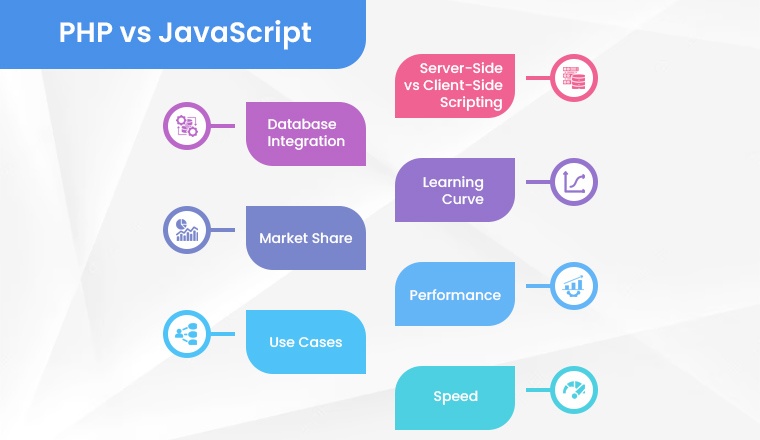
4.1 Market Share
According to W3techs, PHP is quite tenacious when it comes to keeping its market share. By May 2021, PHP had a strong 79.2 % dominance as the server-side programming language for development of web pages. Even if you search on the web for its trends, you will find that PHP will continue to be the leading web server scripting language in the coming years.
So what is the reason? PHP is a server-side programming language that supports prominent frameworks such as WordPress, which according to the Search Engine Journal, provides for 39.5% of all domains. Companies like Wikipedia, MailChimp, Etsy and Slack all utilize PHP for major web pages that are supplied via a LAMP stack or equivalent architecture.
Facebook built various prototypes in PHP before moving to JavaScript, and from these attempts, React JS was conceived. Considering Facebook’s current emphasis on React Relays, it seems unlikely that PHP remains one of their backend programming languages.

In comparison to PHP, JavaScript, specifically Nodejs has a 1.2% market share as the preferred server-side language. Unlike PHP, however, its share is increasing with considerable velocity, adding around 0.4% over the last few years.
4.2 Server-Side versus Client-Side Scripting
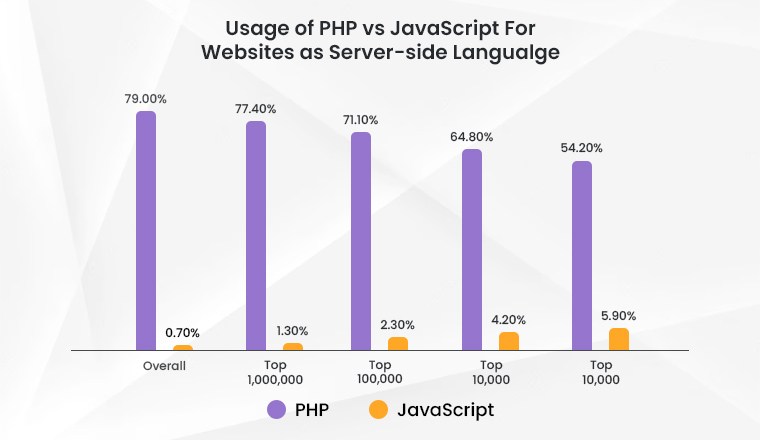
PHP is a language for server-side scripting. This indicates that it operates on a web server rather than a client PC. Server-side programming is handy for sending confidential material to visitors (usually out of databases), including a greeting (“Hello, Jamie!”) when a person checks in.
E-commerce websites use server-side scripting quite extensively. There are approximately 100 WooCommerce plugins that link through APIs (application programming interfaces) to various finance providers in order to execute payments, for instance.
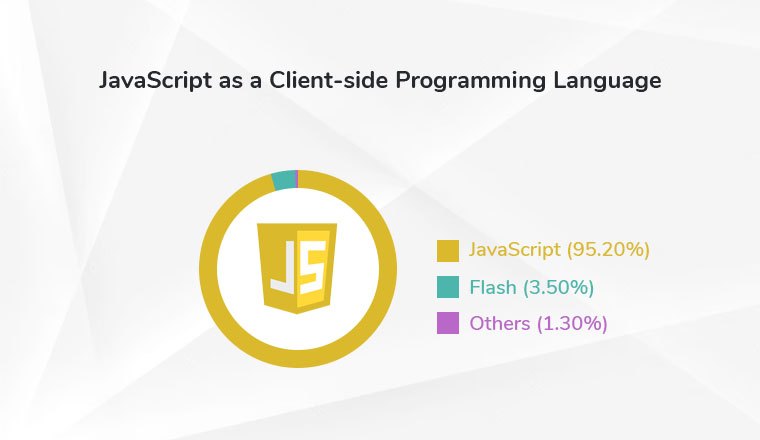
As a client-side language, JavaScript operates on a customer’s laptop, smartphone, or tablet. JavaScript has the ability to alter the Document Object Model (DOM), which is a tree-like architecture built with the HTML of a website.
If you have ever encountered a popup or slider, possibly as part of a Frequently Asked Questions plugin, you have witnessed client-side JavaScript code in operation. When a user clicks or taps on a query, JavaScript event controllers adjust the CSS display or visible settings, displaying or concealing the pertinent response.
4.3 Learning Curve
PHP is far easier to master than JavaScript. Establishing a single .php document is as easy as doing a server setup by entering a paragraph of a program closely remarked with (?php?> tags, and browsing the URL on the internet.
Additionally, PHP idiosyncrasies, such as conflicting features or return PHP variables, are simpler to comprehend and grasp than JavaScript and specific JS frameworks’ oddities.
Setting up JavaScript, specifically Node.js, on the back-end is not difficult. However, it is more challenging than PHP. Beginner Javascript developers require more expertise than a novice PHP developer.
Nevertheless, the time you invest in understanding JavaScript is well worth it. As JavaScript is more ubiquitous than PHP, mastering it provides a greater return on investment. PHP earns a point for its ease of understanding, which novice programmers will enjoy.
4.4 Database Integration
PHP is exceptional at establishing connections to databases. WordPress utilizes MySQL or MariaDB databases, which are both compatible with PHP. Several PHP frameworks also offer simple database connectors.
For finding, classifying, and categorizing data to offer to a customer, like items in an online marketplace, a database is important. Traditionally, JavaScript has not integrated with databases, although this is gradually changing. PouchDB is a JavaScript database sample to collect form data.
4.5 Performance
The Benchmarks Game provides a variety of benchmarks that differs the performance of PHP with JavaScript, with PHP coming out on top in only two out of ten instances.
Interestingly, however, Node javascript consumes far more server resources than PHP, particularly CPU and memory, so the greater speed comes at a price. JavaScript is nonlinear, but PHP is concurrent.
By nature, PHP code is synchronous, which implies the program is consecutive; specific activities must be finished before the next activity can begin, and the CPU can perform only one I/O operation at a time. Jobs are scheduled such that the next job is done after the completion of the preceding task.
It is reasonable to believe that asynchronous PHP programming may improve speed, and one would be accurate. There are PHP plugins that allow asynchronous API requests, like Swoole, a sophisticated API that facilitates HTTP server, WebSocket server, and TCP server setups, among others.
Although PHP alternatives such as Swoole exist, more settings are required to install the plugin, which raises the learning curve for PHP.
In addition, the developer is bound to the library’s API and must get acquainted with every API call and the library’s general functionality. This significantly lengthens the onboarding procedure and reduces the user-friendliness PHP has continuously provided during its existence.
4.6 Use Cases
PHP
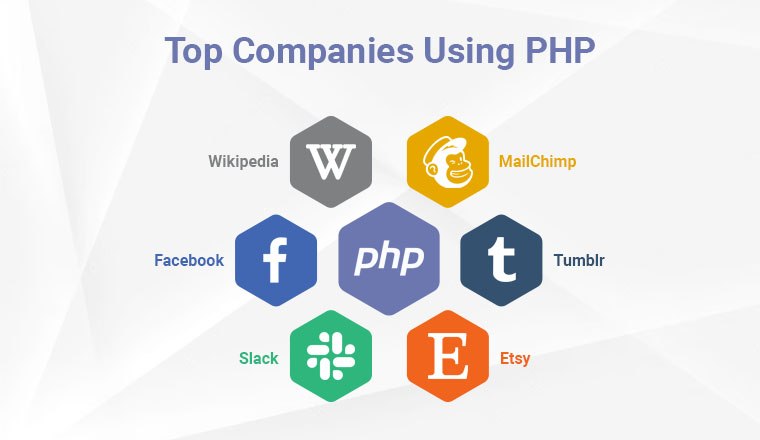
PHP continues to control the private blogging sector due to the ubiquity of WordPress, but also since there has been no compelling incentive for smaller websites to convert their source code.
WordPress is a famous brand among enthusiasts because it provides theming, a sophisticated and scalable Content Management System (CMS), and compatibility on several systems and platforms for online stores, galleries, and other small-scale needs.
Along with WordPress, Laravel, Symfony, Zend, and CodeIgnitor are popular PHP frameworks. Every one of these frameworks provides front-end modules that are strongly connected with respective Content Management Systems (CMS) and are for the back-end.
JavaScript
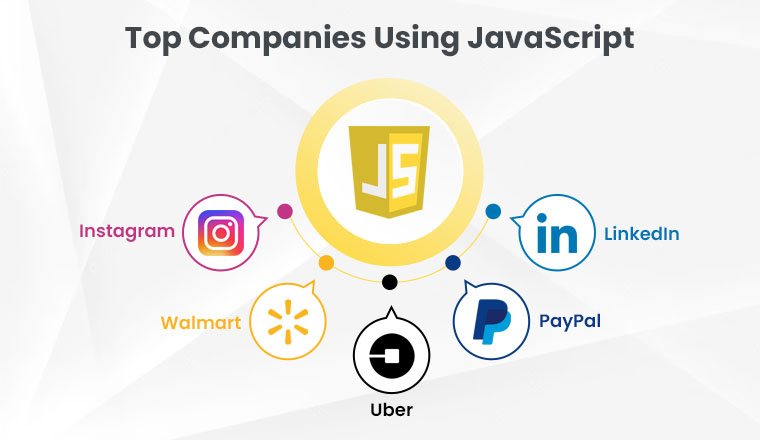
Websites more than a thousand or sometimes even a million pages demand maximum speed with cutting-edge back-end infrastructure and reactive functionality integrated directly into the source code are adopting JavaScript language.
JavaScript frameworks provide an optimized front-end application package that may be used with Node JS back-end technology.
This combines the tech stack so that web developers just have to write code for a single underlying standard, making development convenient. With technologies like React Native, this uniformity is also applied to mobile apps.
Client-side development apps utilize JavaScript technologies. RxJS is a well-known project for creating asynchronous behavior for specific real-time needs.
4.7 Speed
JavaScript often runs quicker than PHP on the same machine. Due to the fact that JavaScript executes as the client-side scripting language, if a client’s computer is aged and slow, then it will affect the runtime.
Since the introduction of PHP version 7.0 , efficiency has increased by jumps and oceans owing to a new architecture that quadrupled speed and reduced memory utilization. PHP 7.0 can manage more than double as many inquiries as PHP 5.6, and speed has continued to increase with each 7. x iteration.
PHP also performs superior to JavaScript when developing real-time apps like chatbots and gaming. The advent of PHP 8.0 featuring the Just-in-Time Compiler would make PHP even quicker.
5. To Wrap Up
This finishes our talk on PHP vs JavaScript. Being widely useful scripting languages and back-end solutions, both JavaScript and PHP are broadly applied for web development, and neither will lose prominence in the near future.
Microservices, containerization, and parallelization of code are only a few trends that were not present when both these tech stacks were launched. In a similar manner, the introduction of ultraportable cellphones and laptops has led to the evolution of electronics. Today, PHP performs an excellent job at supplying dynamic web pages for front-end website development, which is ideal for conventional media such as blog posts, ecommerce stores, and exhibition sites.
There are a plethora of PHP-based plugins for creating and customizing these types of websites, and it is sufficient for the majority of users without regard to efficiency, performance, or any other constraint areas.
Advanced web designs that must scale, utilize resources efficiently, and depend on asynchronous behavior by default are more likely to employ JavaScript than other languages.
Due to these factors, JavaScript pays higher compensation than PHP, yet both PHP and JavaScript are very useful server-side scripting languages. Whichever technology you pick to acquire depends on your objectives, but mastering both PHP and JavaScript can greatly improve your employment possibilities.

Hardik Dhanani has a strong technical proficiency and domain expertise which comes by managing multiple development projects of clients from different demographics. Hardik helps clients gain added-advantage over compliance and technological trends. He is one of the core members of the technical analysis team.
Following the current trend, if you are also moving to CMS (Content Management System) services, creating a website will be easier than ever. Joomla and...
 Sep 30, 2022
Sep 30, 2022 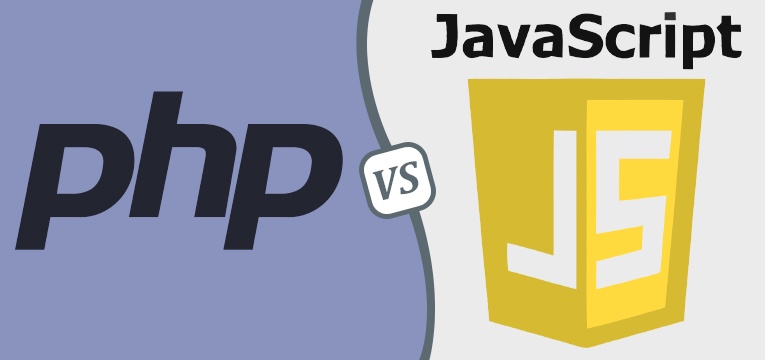



Nowadays, developers have made a mindset that PHP is outdating and they wanted to opt for the latest languages like JS, but to clear this doubt I have to say that PHP is so useful even in today's time and developers have to choose it if they want to make web app with basic features at a lower cost.
Well, comparing PHP with Javascript is not necessarily important because we can use both in the same web app. But you did an excellent job of explaining both languages in detail. A newcomer can easily understand after reading your bylines. Thanks for Sharing!
This topic is really controversial. As we all know both PHP and Javascript are popular for developing web apps, comparing these two in terms of popularity is really difficult but you rightly mentioned both. Indeed a really good blog. Thanks!
Great article about PHP vs JavaScript. I am really liked the way you differentiated both of the tech stacks. Keep sharing some good technical blogs like this. Thanks!